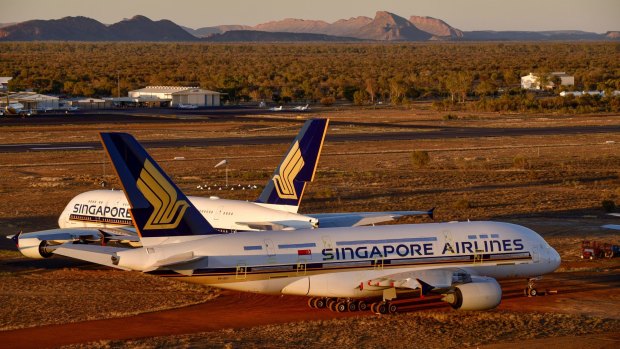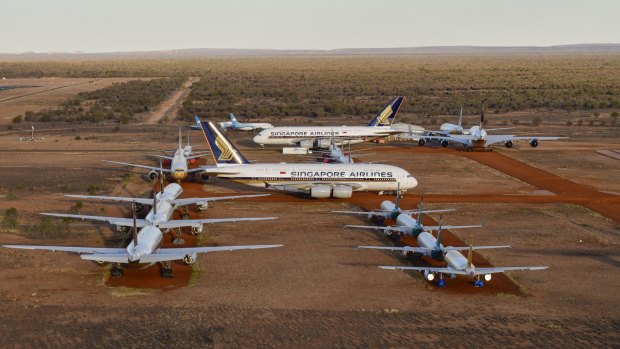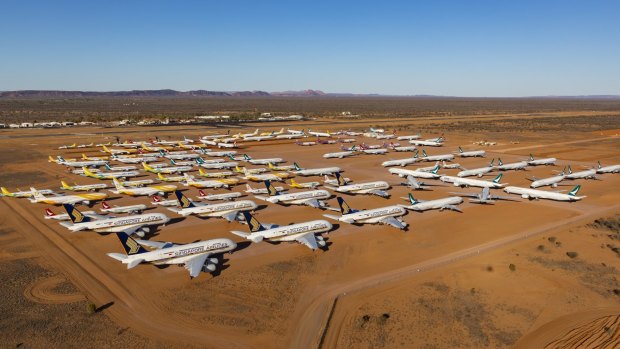This was published 2 years ago
Singapore Airlines A380 kicks up desert dust as it departs Australian storage facility
By Craig Platt

Two Singapore Airlines Airbus A380s stored at Asia Pacific Airline Storage have now left the facility.Credit: Getty Images
What happens when you drive a car at speed along a dirt road? If it's dry, you'll throw up a cloud of dust behind you.
Now imagine what happens when you do the same thing in an Airbus A380 superjumbo, with four Rolls Royce Trent 900 jet engines blasting.
That's what happened last week when a Singapore Airlines A380 departed the desert storage facility Asia Pacific Aircraft Storage (APAS) near Alice Springs.

Singapore Airlines has been storing six of its Airbus A380s in the central Australian desert due to the downturn in demand for air travel.Credit: Getty Images
Video shared on social media caught the take-off of the world's largest commercial airliner, throwing up a massive cloud of reddish desert dust in its wake.
While the runway is sealed, the wingspan of the A380 is such that the engines threw up massive clouds of dust during take-off.
Singapore Airlines has begun moving some of its aircraft out of storage and returning them to Singapore, where the planes are undergoing maintenance and refitting.

The APAS facility near Alice Springs has expanded due to demand.Credit: Seth Jaworski
So far two A380s and all six Boeing 737-8 MAX planes stored there have departed Alice Springs, but Singapore Airlines has not yet set a timeline for returning the planes to service.
"Since the onset of the pandemic we've continued to remain nimble and flexible with aircraft deployment and monitor global demand closely," a spokesperson said. "We currently do not have any plans to return these aircraft to service in the near term."
The airline posted a $S409 million ($410 million) first-quarter loss last week and forecast passenger capacity to reach 33 per cent of pre-pandemic levels in the second quarter. The airline aims to resume flights to at least 50 per cent of its previous destinations by September. Passenger numbers in June improved on 2020's figures for the same month, but remained 96 per cent below the same time in 2019, Reuters reported.
Several airlines have moved planes into storage at APAS due to the downturn in air travel caused by the COVID-19 pandemic. So many, in fact, that last year it found itself running out of space.
Capacity at the site, which has been storing planes for Singapore Airlines, Cathay Pacific, Fiji Airways and Philippines carrier Cebu Pacific, has been expanded, but APAS has also opened a second facility at Wellcamp in Queensland to cope with demand.
Aircraft storage facilities, sometimes called "boneyards" due to airlines sending retired aircraft to them for dismantlement into scrap, are often located in deserts. The dry, arid climate means planes can be preserved in excellent condition before returning to service or being recycled.
Retired aircraft in boneyards are often stripped of parts like engines, electronics and wiring to be recycled.
The world's first A380 superjumbo, which took off in 2007, was decommissioned by Singapore Airlines in 2018 and sent to the storage facility Tarmac Aerosave near Toulouse, France. It was broken up late last year for parts, including turning some of its fuselage into luggage tags.
The APAS facilities are not considered boneyards at this stage, since the airlines using them intended to return their aircraft to service at some stage.
Qantas is storing its grounded planes at a facility in the Mojave Desert in California. The airline has engineers based at Los Angeles International Airport, a relatively short drive away, which made Mojave a more convenient location than Alice Springs, according to the airline.
However, the airline did recently reveal one challenge of the location was rattlesnakes, which have a tendency to sleep inside the landing gear.
See also: Rattlesnakes infest Qantas' grounded A380s in California desert
See also: For sale on LinkedIn: Six slightly used A380 superjumbos
Sign up for the Traveller newsletter
The latest travel news, tips and inspiration delivered to your inbox. Sign up now.